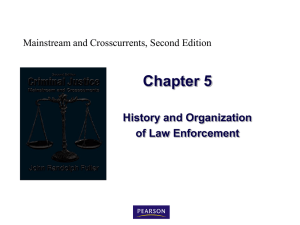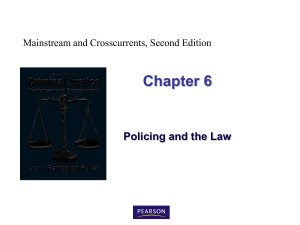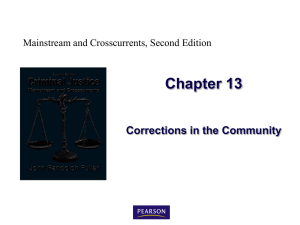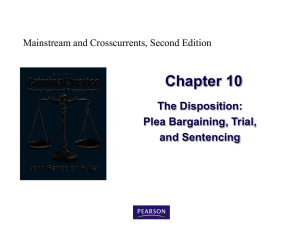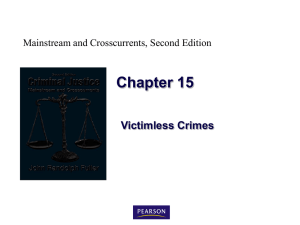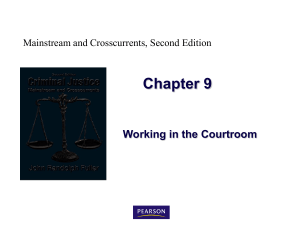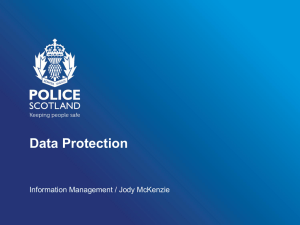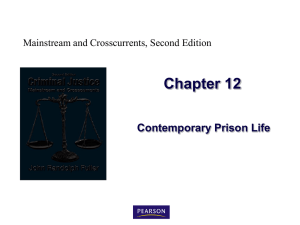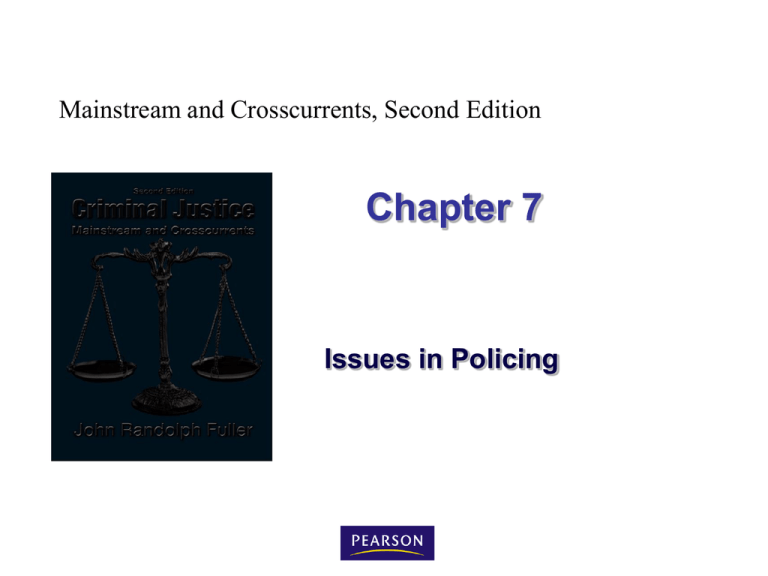
Mainstream and Crosscurrents, Second Edition
Chapter 7
Issues in Policing
Challenges to traditional policing
Community policing
Problem-oriented policing
Zero-tolerance policing
Broken windows theory and police
problems
Criminal Justice: Mainstream and Crosscurrents, 2/e
John Randolph Fuller
2
© 2010 Pearson Higher Education,
Upper Saddle River, NJ 07458. • All Rights Reserved.
Challenges to traditional policing
Community policing
Recalls the watchman style
Attempts to harness community resources
and residents in stopping crime and
maintaining order
Covers a vast array of activities
Criminal Justice: Mainstream and Crosscurrents, 2/e
John Randolph Fuller
3
© 2010 Pearson Higher Education,
Upper Saddle River, NJ 07458. • All Rights Reserved.
Challenges to traditional policing
Problem-oriented policing
Related to community policing
Expands the officer's role from reaction to
proactive problem solving.
Allows agencies to address crime on a
more systemic level than traditional
policing
Criminal Justice: Mainstream and Crosscurrents, 2/e
John Randolph Fuller
4
© 2010 Pearson Higher Education,
Upper Saddle River, NJ 07458. • All Rights Reserved.
Challenges to traditional policing
Zero-tolerance policing
A refinement of problem-oriented policing
Based on the broken windows theory
If every infraction of the law is punished,
offenders will not commit more serious
offenses.
Criminal Justice: Mainstream and Crosscurrents, 2/e
John Randolph Fuller
5
© 2010 Pearson Higher Education,
Upper Saddle River, NJ 07458. • All Rights Reserved.
Challenges to traditional policing
Broken windows & police problems
According to the broken windows
theory, vandalism and criminal activity
are more likely to occur in areas that
appear abandoned or neglected.
Criminal Justice: Mainstream and Crosscurrents, 2/e
John Randolph Fuller
6
© 2010 Pearson Higher Education,
Upper Saddle River, NJ 07458. • All Rights Reserved.
Challenges to traditional policing
Broken windows & police problems
Reasons to be cautious about
broken windows theory …
Misreading of how communities were
policed in the past
Concern for the rights of all citizens
Problem of crime displacement
Criminal Justice: Mainstream and Crosscurrents, 2/e
John Randolph Fuller
7
© 2010 Pearson Higher Education,
Upper Saddle River, NJ 07458. • All Rights Reserved.
Gender and race
Women & minorities as police officers
The number of female officers continues to
increase.
Black officers can be found on nearly every
US police force.
Black officers may experience double
marginality.
Criminal Justice: Mainstream and Crosscurrents, 2/e
John Randolph Fuller
8
© 2010 Pearson Higher Education,
Upper Saddle River, NJ 07458. • All Rights Reserved.
Police use of force
Physical force is considered
legitimate only under the following
circumstances …
Criminal Justice: Mainstream and Crosscurrents, 2/e
John Randolph Fuller
9
© 2010 Pearson Higher Education,
Upper Saddle River, NJ 07458. • All Rights Reserved.
Police use of force
Self-defense
Specifically deputized persons against some
specifically named persons
Police force
Criminal Justice: Mainstream and Crosscurrents, 2/e
John Randolph Fuller
10
© 2010 Pearson Higher Education,
Upper Saddle River, NJ 07458. • All Rights Reserved.
Police use of force
SWAT teams
The militarization of the police and the
war-on-crime analogy are the most
apparent in the Special Weapons and
Tactics divisions of law enforcement
agencies.
Criminal Justice: Mainstream and Crosscurrents, 2/e
John Randolph Fuller
11
© 2010 Pearson Higher Education,
Upper Saddle River, NJ 07458. • All Rights Reserved.
Police use of force
Proactive policing and force
Sometimes the police structure
situations to give crime an
opportunity to occur.
Criminal Justice: Mainstream and Crosscurrents, 2/e
John Randolph Fuller
12
© 2010 Pearson Higher Education,
Upper Saddle River, NJ 07458. • All Rights Reserved.
Police stress and burnout
Police and alcohol
Family problems and the police
Police and suicide
Dealing with the stress of
policing
Criminal Justice: Mainstream and Crosscurrents, 2/e
John Randolph Fuller
13
© 2010 Pearson Higher Education,
Upper Saddle River, NJ 07458. • All Rights Reserved.
Police stress and burnout
Criminal Justice: Mainstream and Crosscurrents, 2/e
John Randolph Fuller
14
© 2010 Pearson Higher Education,
Upper Saddle River, NJ 07458. • All Rights Reserved.
Police stress and burnout
Criminal Justice: Mainstream and Crosscurrents, 2/e
John Randolph Fuller
15
© 2010 Pearson Higher Education,
Upper Saddle River, NJ 07458. • All Rights Reserved.
CrossCurrents Stress and Burnout
Suicide by cop
Refers to suspects attempting to be killed by
police officers.
The police officer is a victim of a purposeful act
by the suspect.
“Police-assisted suicide”?
Criminal Justice: Mainstream and Crosscurrents, 2/e
John Randolph Fuller
16
© 2010 Pearson Higher Education,
Upper Saddle River, NJ 07458. • All Rights Reserved.
Police stress and burnout
Police and alcohol
Stress and the police subculture
may exert a powerful influence on
drinking patterns.
Criminal Justice: Mainstream and Crosscurrents, 2/e
John Randolph Fuller
17
© 2010 Pearson Higher Education,
Upper Saddle River, NJ 07458. • All Rights Reserved.
Police stress and burnout
Police and alcohol
The subculture may socialize new officers
into accepting a pattern of after-shift
drinking.
Socialization in the police subculture
establishes that drinking is not deviant.
Normalization of drinking may preclude
treatment because "every one of my friends
drinks."
Criminal Justice: Mainstream and Crosscurrents, 2/e
John Randolph Fuller
18
© 2010 Pearson Higher Education,
Upper Saddle River, NJ 07458. • All Rights Reserved.
Police stress and burnout
Police and alcohol
Many public safety organizations have
instituted drug and alcohol testing to
ensure that police officers are capable of
performing their jobs.
Criminal Justice: Mainstream and Crosscurrents, 2/e
John Randolph Fuller
19
© 2010 Pearson Higher Education,
Upper Saddle River, NJ 07458. • All Rights Reserved.
Police stress and burnout
Family problems & the police
The individual police officer is not
the only one affected by stress.
Family members often experience
stress, as well.
Criminal Justice: Mainstream and Crosscurrents, 2/e
John Randolph Fuller
20
© 2010 Pearson Higher Education,
Upper Saddle River, NJ 07458. • All Rights Reserved.
Police stress and burnout
Family problems & the police
Officers may appear withdrawn and
disinterested in the family.
Family members may fear for an officer's
safety.
Rotating shifts may cause hardships.
Criminal Justice: Mainstream and Crosscurrents, 2/e
John Randolph Fuller
21
© 2010 Pearson Higher Education,
Upper Saddle River, NJ 07458. • All Rights Reserved.
Police stress and burnout
Police and suicide
Many studies have shown that law
enforcement has one of the highest
suicide rates of any occupation.
Criminal Justice: Mainstream and Crosscurrents, 2/e
John Randolph Fuller
22
© 2010 Pearson Higher Education,
Upper Saddle River, NJ 07458. • All Rights Reserved.
CrossCurrents Stress and Burnout
Another look at police suicide
Some studies show high rates of police suicide.
Robert Loo: There are problems with the way
police suicide rates are calculated.
Compare officers to their demographic
characteristics.
Criminal Justice: Mainstream and Crosscurrents, 2/e
John Randolph Fuller
23
© 2010 Pearson Higher Education,
Upper Saddle River, NJ 07458. • All Rights Reserved.
Police stress and burnout
Dealing with the stress of policing
Arrigo and Garsky make three
suggestions to reduce police stress…
Stress management and stress reduction
techniques
Group process sessions
Police mentoring
Criminal Justice: Mainstream and Crosscurrents, 2/e
John Randolph Fuller
24
© 2010 Pearson Higher Education,
Upper Saddle River, NJ 07458. • All Rights Reserved.
Police subculture
and police corruption
Policeman's working personality
explains how police officers are drawn
into a subculture that emphasizes a
different set of values from those of
mainstream society.
Criminal Justice: Mainstream and Crosscurrents, 2/e
John Randolph Fuller
25
© 2010 Pearson Higher Education,
Upper Saddle River, NJ 07458. • All Rights Reserved.
Police subculture and police corruption
Policeman's working personality
Key elements
Symbolic assailant
Danger
Social isolation
Solidarity
Criminal Justice: Mainstream and Crosscurrents, 2/e
John Randolph Fuller
26
© 2010 Pearson Higher Education,
Upper Saddle River, NJ 07458. • All Rights Reserved.
Policeman's working personality
Symbolic assailant
Police officers are systematically trained
and culturally reinforced to consider
everyone a potential assailant until they
determine that an individual poses no
threat.
Criminal Justice: Mainstream and Crosscurrents, 2/e
John Randolph Fuller
27
© 2010 Pearson Higher Education,
Upper Saddle River, NJ 07458. • All Rights Reserved.
Policeman's working personality
Danger
Although death in the line of duty and serious
physical injury are not frequent, the possibility of
confrontation is always there.
Criminal Justice: Mainstream and Crosscurrents, 2/e
John Randolph Fuller
28
© 2010 Pearson Higher Education,
Upper Saddle River, NJ 07458. • All Rights Reserved.
Policeman's working personality
Social Isolation
Police officers may perceive an individual as a
symbolic assailant, but the public sees the
police officer as a symbolic authority figure.
Skolnick: social isolation causes many officers to
limit their social interactions.
Criminal Justice: Mainstream and Crosscurrents, 2/e
John Randolph Fuller
29
© 2010 Pearson Higher Education,
Upper Saddle River, NJ 07458. • All Rights Reserved.
Policeman's working personality
Solidarity
The combination of danger and social isolation
creates a sense of solidarity in the police
subculture.
“Us against them” mentality is possible.
Criminal Justice: Mainstream and Crosscurrents, 2/e
John Randolph Fuller
30
© 2010 Pearson Higher Education,
Upper Saddle River, NJ 07458. • All Rights Reserved.
Questions
What is community policing?
What is problem-oriented policing?
What is broken-windows theory?
Criminal Justice: Mainstream and Crosscurrents, 2/e
John Randolph Fuller
31
© 2010 Pearson Higher Education,
Upper Saddle River, NJ 07458. • All Rights Reserved.



